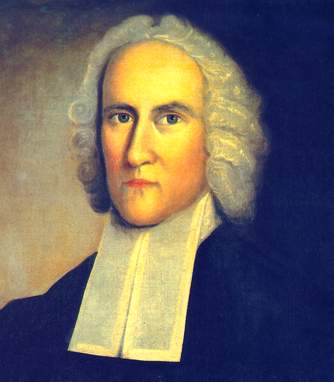Historical Development of Wesley’s Doctrine of the Spirit

Jonathan Edwards
There are three significant events that helped him overcome this impasse in his spiritual pilgrimage and played an important role in his pneumatological development. First, on October 9, 1738, while walking from London to Oxford, he began to “read the truly surprising narrative of conversions lately wrought in and about the town of North Hampton in New England.”29 Wesley fully accepted Jonathan Edward’s analysis of the “distinguishing marks of the work of the Spirit of God.”30 From reading Edwards’s treatise, he saw the significance of the outward work of the Spirit in New England and was unknowingly building a foundation for his doctrinal understanding of the work of the Spirit in the Methodist revival.
The second major event was when Wesley made a critical reappropriation of the Anglican Homilies, which pointed him back to the “much controverted point of Justification by Faith,” and widened the theological gap between Wesley and the Moravians.31 He found within his own Anglican heritage the answers to many of the theological quandaries that he had with the Moravians. As a result, he published them in an extract for the use of others.32 Outler notes that this marked the final stage of Wesley’s maturation as a theologian; “his encounter with Edwards and his vital reappropriation of his Anglican heritage-the frame of Wesley’s theology was finally set, and would so remain there after.”33
The third event took place in 1739. Wesley had been preaching in different parishes, but his new message of “salvation by faith” was not received well by the established Church of England. On November 30, 1738 George Whitefield returned from a successful ministry tour in America. Whitfield’s method was ‘field preaching’ in the open air to the common people. On April 2, 1739, Whitfield convinced Wesley to preach in his absence in the open air in Bristol. John reflected on the occasion in his journal, ” I submitted to be more vile, and proclaimed in the highways the glad tidings of salvation, speaking from a little eminence in a ground adjourning to the city about three thousand people.” 34
This event marked the beginning of John Wesley’s evangelistic ministry and a further maturation in his pneumatology. His emphasis on the work of the Holy Spirit began to move from the internal work of the Spirit (new birth, witness of the Spirit) to the external work of the Spirit (witness and fruit of the Spirit) among the people. Heiztzenriter points out that Wesley’s quest “becomes less singularly personal as he begins to sense the work of the Holy Spirit in the midst of the people, a phenomenon not unlike what he had read about in Jonathan Edward’s writings.”35 Wesley was able to make a synthesis of these events and integrate them into his overall pneumatology. His doctrine of the Spirit was not changing as much as it was maturing and broadening to include the outward work of the Spirit. The outward signs of the Spirit among the people proved the authenticity of the gospel message he preached.
The sermons during this period show a progression and maturation in the development of Wesley’s doctrine of the Spirit. Sermons prior to 1738 say little concerning the Holy Spirit, but in the following years, the sermons begin to discuss in greater detail the work of the Spirit as a regular part of the Christian life by including an emphasis on the witness and fruit of the Spirit. Outler notes that “in a series of published sermons in 1746-48 he began to sort out his doctrine of grace in a perspective that is explicitly pneumatological and implicitly Trinitarian.”36 Beginning with the early 1740’s, there is a rise of Spirit language in Wesley’s sermons that continued throughout his life. This development in his sermons demonstrates a more mature and holistic pneumatology in Wesley’s thought.
“Salvation by Faith” 1738
On June 11, 1738, Wesley preached a sermon entitled “Salvation by Faith” at Oxford University before his Oxford colleagues just a month after Aldersgate. The sermon represented a shift from good works to salvation by faith and became a manifesto of the Methodist revival. This sermon marks a clear shift in his theology from salvation by works to salvation by faith. The role of the Spirit is also clearly defined in the process of salvation. He said that those who were saved by faith were ‘sealed with the Spirit of promise, which is the earnest of their inheritance'; ‘and the love of God is shed abroad in their hearts through the Holy Ghost which is given them'; and they are ‘born again of the Spirit unto a new life which is hid with Christ in God.”37 Wesley is placing a more articulate emphasis on the role of the Holy Spirit in the believer who is saved by faith. He makes another reference to assurance by saying, “The Spirit itself also bearing witness with their spirits, that they are the children of God.”38 In this sermon we can see that Wesley is beginning to integrate the Spirit’s work into his theology. By this time the Spirit is becoming a central focus in Wesley’s soteriology.
“Scriptural Christianity” 1744
In a sermon preached at St. Mary’s on August 24,1744, entitled “Scriptural Christianity”, Wesley clearly emphasizes the role of the Holy Spirit in the life of a Christian. His chosen text was “And they were all filled with the Holy Ghost.” Acts 4:31. Wesley was not concerned with the extraordinary gifts of the Spirit, rather the ordinary fruit that should accompany the life of a true Christian. He said:
Whether these gifts of the Holy Spirit were designed to remain in the church throughout all ages, and whether or not they will be restored at the nearer approach of the “restitution of all things,” are questions which it is not needful to decide It was, therefore, for a more excellent purpose than this, “they were all filled with the Holy Ghost.”39
Category: Church History


